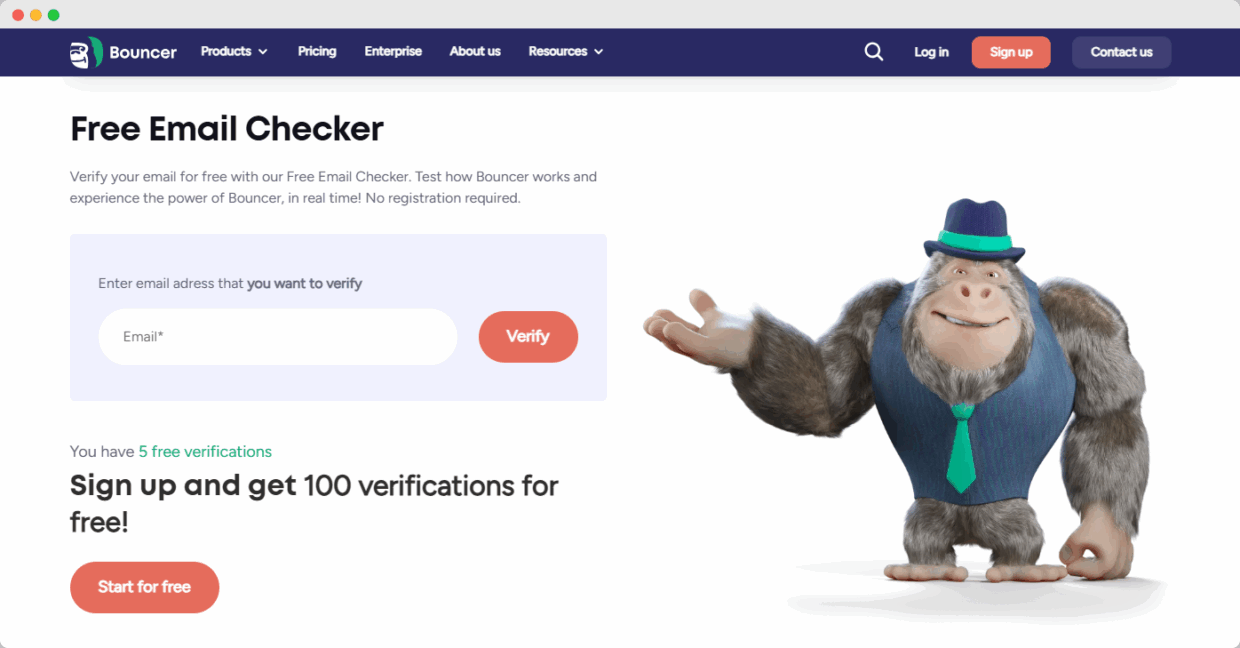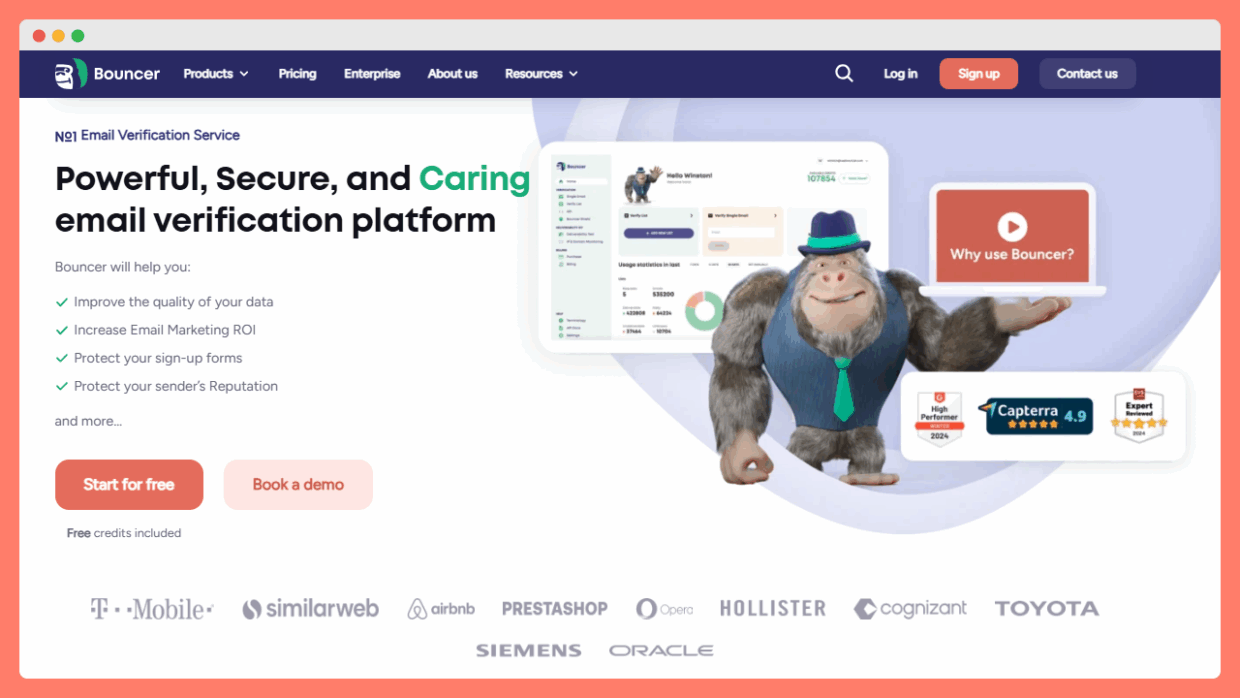That’s where an email bounce checker steps in. Forget the days of blindly blasting messages and hoping for the best. Today, the best teams use email bounce checkers to spot risky addresses, protect sender reputation, and ultimately, get their message delivered.
But what exactly is an email bounce checker? How does it work? And – let’s be honest – do you actually need one, or is it just another “nice-to-have” tool in the crowded world of marketing software?
Here’s the full story, from the basics to the advanced tricks that separate the email pros from the rest.
What is an email bounce checker?
At its core, an email bounce checker is a tool (often online, sometimes built right into your email platform) that checks whether an email address is valid and deliverable before you send your campaign. It does the digital equivalent of knocking on the door and checking if anyone’s home, so you’re not just throwing messages into the void.
But why bother? Because every email you send to an invalid address can damage your sender reputation, reduce inbox placement, and mess up your marketing data. No one wants that.
Types of bounces: not all bounces are equal
It helps to know there are two main types of bounces:
- Hard bounces: These happen when you send a message to an email address that simply doesn’t exist (think typos, old accounts, fake signups). These are permanent failures.
- Soft bounces: These are temporary issues, like a full inbox, a server glitch, or the recipient’s email provider being down for a bit. Sometimes these resolve themselves, but repeated soft bounces can still cause trouble.
A good email bounce checker helps you identify both, but especially the hard bounces—the ones that can hurt your sender reputation fast.
Why bother with an email bounce checker?
You might be thinking, “Can’t my email marketing platform just handle this for me?” In reality, most platforms will only tell you about bounces after you hit send – after the damage is done.
Here’s why bounce checkers matter:
- Protect your sender reputation. ISPs and email service providers (ESPs) keep tabs on your bounce rates. High bounce rates are a red flag that your list is messy—or worse, that you’re sending spam. Over time, you could get blacklisted or see your emails sent straight to spam.
- Improve deliverability. Fewer bounces mean more emails reach real people. It’s that simple. The best marketing teams obsess over deliverability because it directly affects ROI.
- Save money on email marketing. Most platforms charge you based on the number of messages you send or the size of your list. Why waste budget on undeliverable addresses?
- Cleaner data = better insights. An accurate, up-to-date list helps you measure engagement and plan smarter campaigns. Bad data leads to bad decisions.
- Avoid spam traps and complaints. Old, recycled addresses (or fake ones) can turn into spam traps. Sending to these addresses can get you blocklisted or hurt your deliverability.
In short: if you’re serious about email marketing, an email bounce checker is essential.

How does an email bounce checker actually work?
Good question. It’s a mix of clever technology, real-time database checks, and a bit of digital sleuthing. Here’s the short version:
- Syntax check. Is the email address even formatted correctly? (Example: “john..doe@@domain.cmo” gets caught right away.)
- Domain & MX records check. Does the domain exist? Is it accepting email? The tool looks up DNS records to see if the domain can actually receive messages.
- Mailbox ping (without sending real email). Here’s where it gets clever. The bounce checker simulates a connection with the recipient’s mail server, asking, “Is this mailbox real and accepting messages?” No email is actually sent.
- Blacklist & spam trap screening. Advanced tools cross-check addresses against known lists of spam traps or problematic domains.
- Disposable & role-based address detection. Some tools can flag addresses like “info@,” “sales@,” or temporary emails, which might not be valuable for campaigns.
The best tools handle all of this at scale, giving you a “valid,” “invalid,” or “risky” verdict for every address in your list.
Free vs. paid email bounce checkers: what’s the difference?
There are a ton of free email checkers and “free email verification tools” online. Some work well for quick checks.

But if you’re running a real business or handling sensitive data, tread carefully.
Free email checkers
- Great for small lists or occasional spot-checks.
- Usually limited in terms of daily or monthly checks.
- May not offer in-depth analysis (no spam trap checks, no API access).
- You’re often the product—data privacy might be a concern.
Paid email verification tools
- Handle big lists and bulk uploads quickly.
- Offer deep, multi-step verification (syntax, domain, mailbox, spam trap, etc.).
- Usually come with guarantees on accuracy and uptime.
- Better privacy standards and compliance (GDPR, CCPA, etc.).
- Can be integrated directly into your signup forms, CRM, or marketing platform via API.
For anything beyond personal use, a reputable, paid tool is usually worth it, especially when you factor in the cost of poor deliverability or a blacklisted sender reputation.
What makes a good email bounce checker?
Not all tools are created equal. When you’re choosing a bounce checker, look for:
- Accuracy: The whole point is to weed out invalid addresses. Check reviews, look for published stats, and (if possible) test with your own data.
- Speed: You don’t want to wait hours for your list to be verified. Top tools process thousands of addresses per minute.
- Ease of use: A clean, intuitive UI matters. The tool should fit into your workflow, not slow it down.
- Integrations: Can you plug it directly into your CRM, marketing platform, or signup forms? Modern teams need seamless workflows.
- Security and compliance: Handling customer data is serious business. Look for GDPR compliance, data encryption, and a solid privacy policy.
- Detailed reporting: Good bounce checkers don’t just say “valid” or “invalid”—they break it down (catch-alls, disposable emails, spam traps, risky addresses) so you can act accordingly.
- Customer support: When you have questions, you want answers—fast.

Real-world use cases: when an email bounce checker is a must
Let’s get specific. Here’s when you absolutely need a bounce checker:
Importing or buying a list
Maybe you just got a list from a tradeshow or a new marketing partner. Don’t risk your sender reputation—run it through a checker first.
Cleaning old or dormant lists
If your list hasn’t been emailed in months (or years), check it. People change jobs, abandon addresses, and ISPs recycle old accounts.
Protecting sign-up forms
Fake signups happen—bots, bored competitors, people who don’t want your emails. Plug a bounce checker into your signup form (via API) to stop junk at the source.
Before big campaigns
Launching a major product update or running a re-engagement campaign? Clean your list first to maximize impact and avoid disaster.
Periodic list maintenance
The best marketers set a calendar reminder to check their lists regularly – monthly, quarterly, whatever fits. Prevention beats damage control every time.
Common questions and misconceptions
Can’t I just send emails and let my platform remove the bad ones?
You can, but you’ll pay the price in sender reputation and wasted budget. Prevention is always cheaper than a cure in email marketing.
Will a bounce checker stop spam complaints?
It’ll help, but it’s not a silver bullet. Complaints are often about content or frequency. But removing risky or fake addresses reduces your chances of triggering spam filters.
Do I really need to check every new sign-up?
If you want to keep your list clean, yes. Many tools offer real-time API integration, so bad emails never make it onto your list in the first place.
Choosing the right tool: what to look for
If you’re ready to level up your deliverability, here’s a quick checklist:
- Start with a free trial: Most reputable tools offer some free credits or checks so you can test accuracy and usability.
- Compare feature lists: Do you need bulk verification, API access, or advanced reports? Don’t overpay for features you’ll never use.
- Read real user reviews: Look for feedback on accuracy, speed, and support—not just marketing hype.
- Check privacy and compliance: Especially if you’re handling EU data, GDPR compliance is non-negotiable.
- Test integrations: Make sure it works with your CRM or marketing stack.
Advanced features: beyond the basics
Modern bounce checkers do more than just weed out invalid addresses. Some of the best also:
- Detect spam traps and toxic emails: Avoid addresses that could land you on blocklists.
- Score email addresses: Assign a “quality score” so you can prioritize outreach to your best leads.
- Provide deliverability reports: See which domains are most problematic and adjust your targeting.
- Integrate with marketing tools: Automatically verify emails at the point of entry—no manual work required.
These features give you more control, better insights, and less risk. If you’re serious about email marketing, they’re worth looking for.
The bottom line
In the world of email marketing, your sender reputation is everything. An email bounce checker is your insurance policy—it protects your campaigns, budget, and brand from the hidden dangers of undeliverable addresses, spam traps, and poor data quality.
Yes, it’s an extra step. But it’s one that pays off every time you hit “send” and see real, measurable results. Clean lists mean more delivered messages, higher ROI, and less stress.
If you’re not using an email bounce checker yet, now’s the time. Start small—test a tool with your next campaign. See the difference. Once you realize how much cleaner your inbox placement and reporting look, you’ll wonder how you ever ran email campaigns without it.
When it comes to reliable email address verification, Bouncer stands out as the best email bounce checker for modern companies.
With Bouncer, you can easily verify email addresses on your mailing lists, spot every invalid email address, and ensure only valid email addresses make it through. Its powerful email validator goes beyond simple checks—detecting invalid, disposable email addresses, catch-all domains, and risky emails that can hurt your deliverability.

The platform’s email verification API lets you validate emails in real time, while bulk tools make it effortless to verify lists of any size. With a free account, any company can start cleaning email lists and reducing bounce rates immediately. Bouncer integrates with your favorite email marketing tools to flag undeliverable emails, improve email deliverability, and protect your sender reputation for various reasons (whether you’re validating new signups or refreshing your full list). Don’t risk a poor reputation, trust Bouncer to keep your emails deliverable.
Ready to give your campaigns the best shot at the inbox? Don’t let a dirty list hold you back—find the right email bounce checker and start seeing results.


